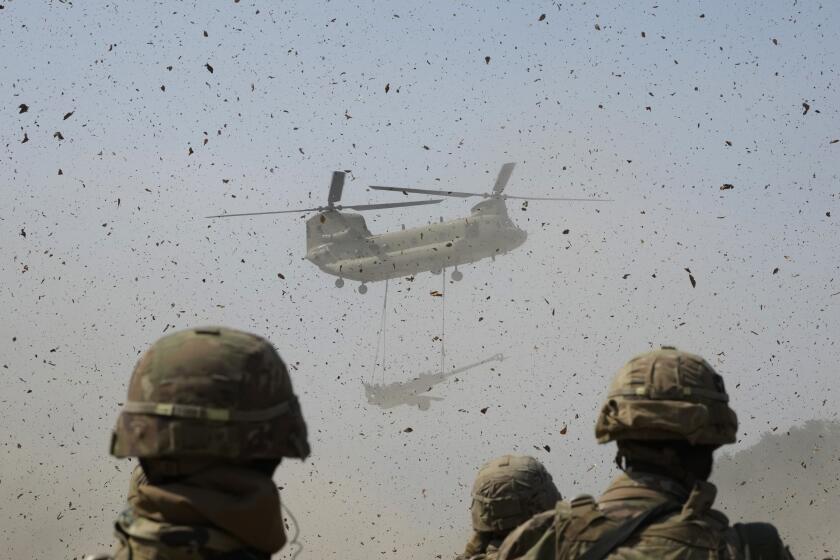Despite an Air of Mystery, Downing of Korean Jetliner Puts a Chill on Peninsula
- Share via
Korean Airlines lost another plane on Nov. 29, but, unlike the KAL 007 tragedy in 1983, this one received little attention. The plane took with it 115 lives--mostly workers returning from construction projects in the Middle East--and a real chance for reducing tension in a peninsula where two huge Korean armies, 41,000 American soldiers and a few hundred U.S.-controlled nuclear weapons are in place. The plane crashed as it neared Bangkok en route to Seoul. A man and a woman, said to have planted a bomb on the plane, tried to commit suicide when caught with forged passports in Bahrain; the man succeeded.
Both had the name Hachiya, according to initial reports suggesting that they might have been linked to the terrorist Japanese Red Army faction. South Korean sources soon said that the woman was a Japanese named Mayumi Yakabe and that the man was a Korean named Li Kyung-u who had been a guerrilla in South Korea in the late 1940s, later fleeing to Japan. They were North Korean agents, Seoul said.
In mid-December Bahrain turned the woman over to South Korean authorities, who took her back to Seoul. Tape covered her lower face as she moved through the airport. After a month’s interrogation the woman appeared on Korean television, and it developed that she was not Mayumi Yakabe, but Kim Hyon-hui, a North Korean citizen ordered to bomb the airliner by the heir-apparent in Pyongyang--President Kim Il Sung’s son, Kim Jong Il--to warn people away from the Olympics in Seoul. The United States and Japan proceeded to impose sanctions on Pyongyang.
North Korea adamantly denied any involvement, saying that it would never attack Korean workers, that it condemned terrorism and that no such woman had ever lived in the north. Tass backed the North Korean account, but China conspicuously refused to pass judgment.
Such are the known facts. Assuming that North Korea was responsible, it is a sharp departure from previous behavior. Pyongyang has never before targeted innocent civilians, its terrorist actions having been designed to remove South Korean leaders. South Korea has been free of the bombings, assassinations and guerrilla attacks common in the Middle East. Blowing up a plane thus would suggest that the north is increasingly desperate, and dangerous.
Unfortunately, past practice by South Korean authorities makes it impossible for an independent observer to trust them. Confessions wrung through torture are still common. Just a year ago a respected student leader died during police “water treatment.” Fifteen months ago the south put out odd stories about Kim Il Sung having been assassinated, which quickly dissolved when Kim turned up healthy. So the inclination to believe them this time--the confession seemed compelling--is mitigated by experience. The timing of the unveiling of the woman was also suspect, coming just after the Soviets and the Chinese had agreed to participate in the Olympics. Seoul’s policy all along has been to isolate Pyongyang as much as possible during the Olympics, and to attract as many of the north’s allies as possible.
The American decision to impose sanctions was based on the confession and other unspecified evidence. The North Korean Foreign Ministry then announced its own retaliatory sanctions against the United States, but also included a statement claiming that the United States had worked out a “scenario” to blow up the airplane of the South Korean foreign minister in May, 1988, during his visit to Japan, as a pretext for “warfare against North Korea.” This outlandish assertion suggests at a minimum that the next few months will be tense.
The United States and South Korea will soon begin annual “Team Spirit” military exercises, the world’s largest in recent years. North Korea seems increasingly to have its back to the wall, isolated from its allies and condemned by world opinion for the KAL incident.
These events have ended a period of hopeful developments over the previous year, with a number of informal talks between U.S. and North Korean diplomats. The north reduced its sizable army by 100,000 soldiers last summer as a conciliatory gesture, and Kim’s recent New Year’s address was the mildest in years.
I was in North Korea in November with a group from Thames Television in London. For the first time the north allowed a Western film crew to interview a wide range of people for a documentary on the Korean War. I heard many expressions of desire for better relations with America. I saw a lot of Olympic-related construction. We stayed in a new world-class, 45-story hotel and saw another being built.
Kim Il Sung said in his New Year’s address that the recent intermediate-nuclear-forces treaty indicated a “current trend to peace”; on Korea, he said, “even though it is difficult to reunify the country right now, we must seek a way to a peaceful life instead of pitting large armies against each other and keeping factors that may trigger off a war and bring about national calamities.” It is not his usual rhetoric. It represents a conciliatory policy in place for the past year, and a sharp counterpoint to the destruction of the plane. But the KAL tragedy has taken down with it any chance for reducing tensions in the near term.
More to Read
Sign up for Essential California
The most important California stories and recommendations in your inbox every morning.
You may occasionally receive promotional content from the Los Angeles Times.











